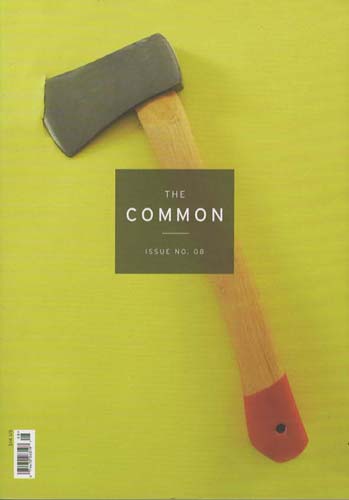The Common – Fall 2014
I haven’t reviewed many literary journals despite my sixty-something years on earth, since many of those years were spent in the Navy and at sea. I’ve never read a journal cover-to-cover until I perused the Fall 2014 issue of The Common, a relatively new journal, first published in 2011, and headquartered at Amherst College. And I didn’t expect it to make me feel like this was my journal; like I’d selected all of the pieces I want to find in a journal: fiction, poetry, essays, and photography.
I haven’t reviewed many literary journals despite my sixty-something years on earth, since many of those years were spent in the Navy and at sea. I’ve never read a journal cover-to-cover until I perused the Fall 2014 issue of The Common, a relatively new journal, first published in 2011, and headquartered at Amherst College. And I didn’t expect it to make me feel like this was my journal; like I’d selected all of the pieces I want to find in a journal: fiction, poetry, essays, and photography.
Carefully stuffed like the contents of my sea bag into this issue’s pages are seven fiction pieces, three essays, twenty-seven poems from twenty poets, photography—black and white and compelling—and an introduction from the editor-in-chief, Jennifer Acker, that reads like a wonderful piece of creative nonfiction in its own right. That’s a lot to digest, but it all goes down smoothly.
For example, there’s the very entertaining short story, “Reichelt’s Parachute,” by Ian Bassingthwaighte. I thought I was reading a piece of nonfiction, so convincing is this narrative about Gustave Eiffel, architect of the Parisian tower named for him, and the son of one of the tower’s construction workers. Upset when he learns of the death of an assistant riveter, Gustave kicks a wine bottle through the flimsy wall of his apartment to find a boy, Franz, whom he spotted cradling the dead worker—the apprentice of the boy’s father—on the other side. The hole is an opening to more than two homes; it leads to the pair’s lifelong friendship. Gustave, over the years, becomes Franz’s mentor. The tale ends with Gustave placing his very life into the hands of his friend and fellow inventor, the child who embraced Gustave’s trust in the laws of science as he did the body of his father’s apprentice.
Sarah Smarsh’s essay “Death of the Farm Family” is an emotional and illuminating work of nonfiction. Smarsh successfully recaptures the part of her life she indicates was the most important: growing up on a farm in Kansas. She recalls her childhood with a grandmother who, with Smarsh’s mother, had crisscrossed the country before finding a home in the country. She poignantly writes of her days with the man who married her grandmother and who helped her find her way into adulthood.
With so many poems to relish, I had no trouble picking Robert Cording’s “Homeward” as a favorite. Written in free verse, it consists of three eight-line stanzas, with no apparent rhyme scheme. I connected instantly with its narrative: taking a walk around the neighborhood of one’s home in late November. Perhaps it was the time I read it, yes, in late November. What I found most captivating and most true in my case was: “Nostalgia: / the pain of it, how it cleaves return.”
Art in this issue is attributed to Robert Adams. Four black and white photographs are described in an essay by Brian Sholis. I did find it unusual that his photos are the only pieces classified as “art,” though there are three other sections of black and white photography included in other works.
The Common is a journal I found to be entertaining, informative, thought-provoking, and above all else for me, comforting. I enjoyed the flow of the magazine; how the works were placed and spaced; and the overall tone. It’s a journal I will continue to read and to follow.
[www.thecommononline.org]
Reviewer bio: J. Thomas Minton is a retired Naval Officer (Cryptology). Currently a student in the M.A. in Writing program at Coastal Carolina University, he is an editorial assistant for the online literary journal Waccamaw.





